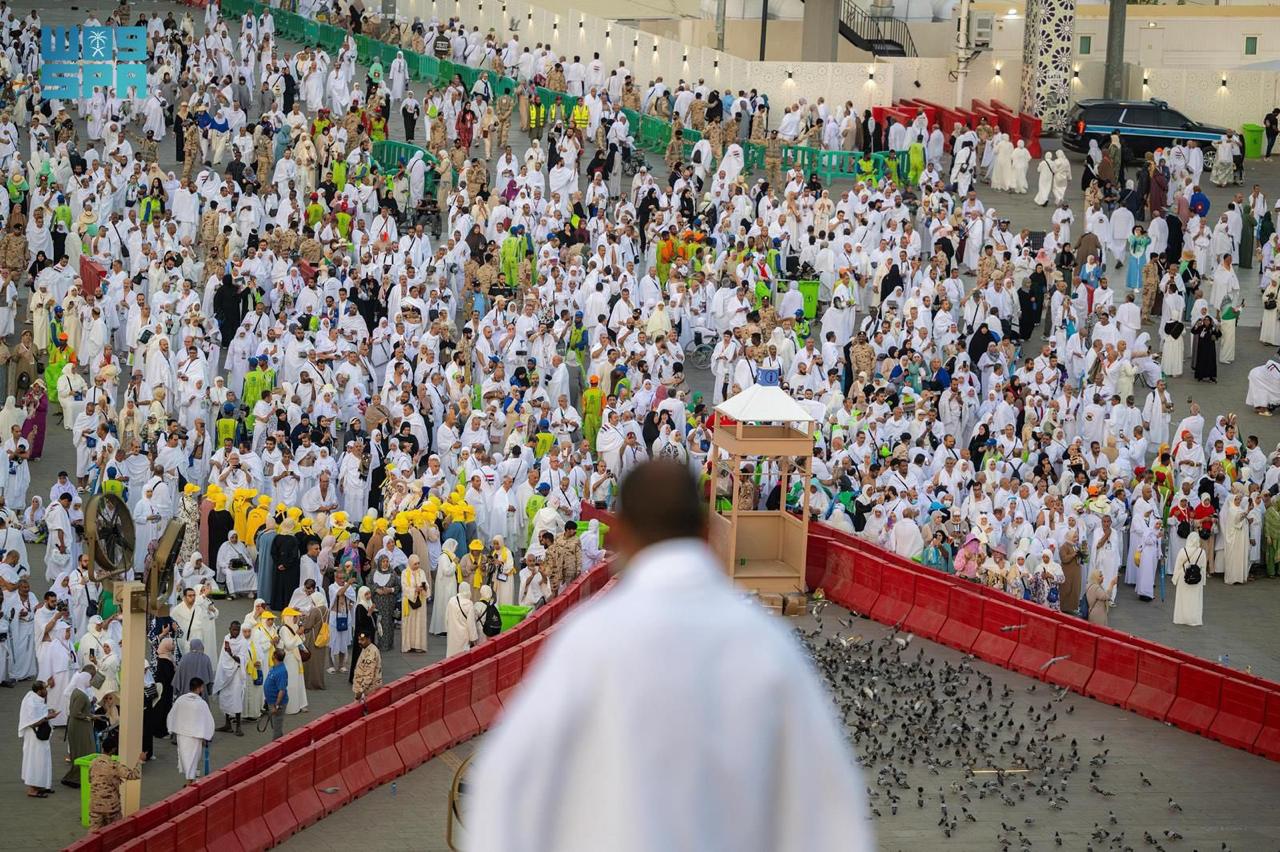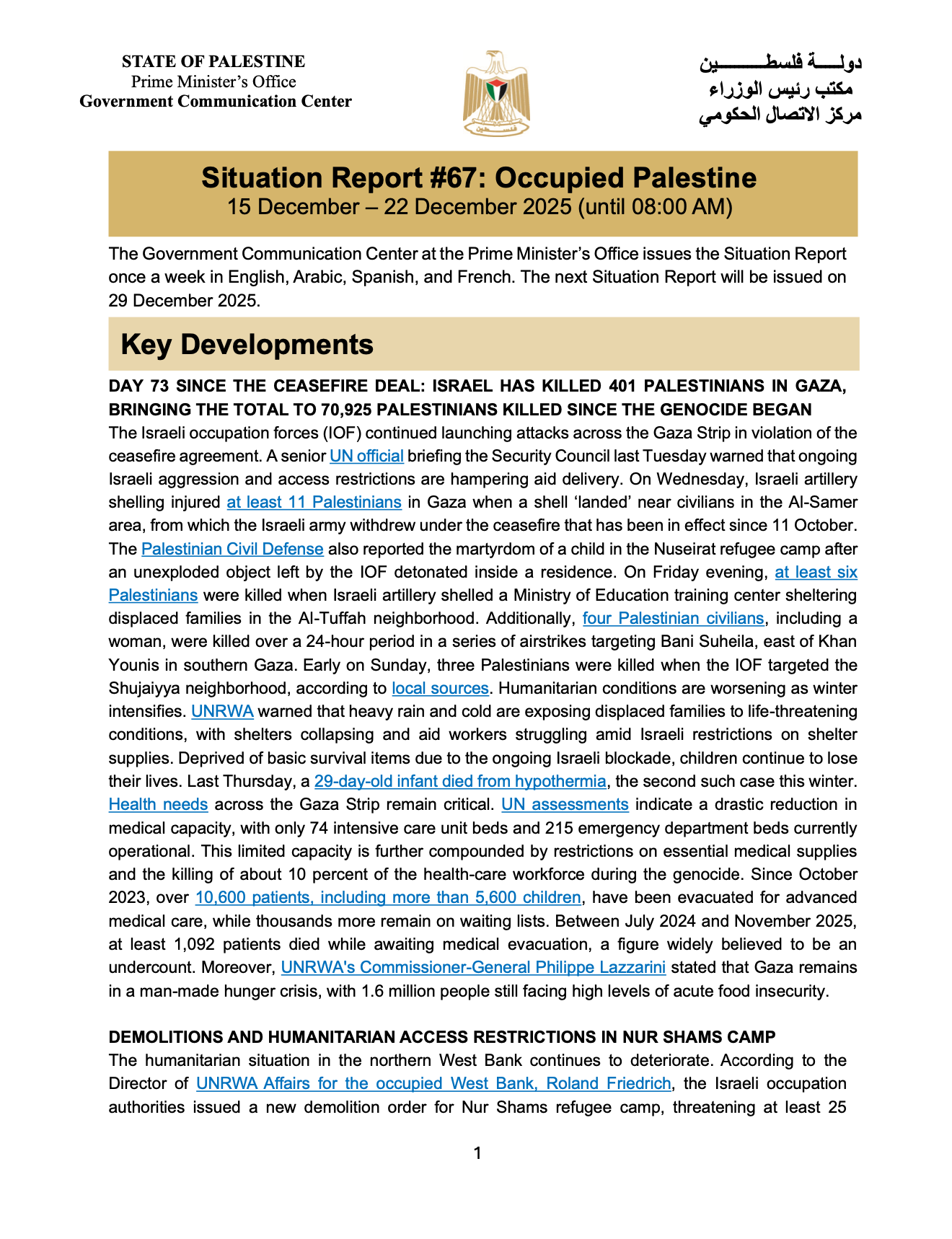MAKKAH, June 6, 2025 (WAFA) - Pilgrims of the Holy Mosque are performing the rituals of Hajj for this year, 1446 AH, within an integrated framework of services provided by the Government of the Kingdom of Saudi Arabia. These services accompany the pilgrims throughout their journey—from their arrival in the Holy Land, through their movement during the pilgrimage rituals, until their departure after completing their Hajj.
These quality services reflect the synergy and harmony between technology and human efforts to serve the Guests of Allah and enrich the Hajj experience, in line with the sanctity and noble meaning of this great ritual.
At the level of healthcare services, the government designated a range of advanced hospitals and health facilities equipped with all the necessary technologies and medical equipment to ensure pilgrims receive the highest levels of care and immediate response to any emergencies.
In the plain of Arafat, where pilgrims stand on the 9th of Dhul Hijjah, several hospitals have been prepared, including the Mount Mercy Hospital and the Field Medical Services Hospital, which is one of the most prominent medical service projects for this year’s Hajj season. It has a capacity of 100 beds and includes comprehensive facilities: 20 beds designated for heat exhaustion cases, a full-fledged operating room, an isolation room, and a mobile medical unit equipped with five field clinics, a medical laboratory, a pharmacy, and portable radiology equipment—reflecting high readiness and comprehensive preparedness to provide immediate and field healthcare to the Guests of Allah.
In Mina, where pilgrims spend the Days of Tashreeq, there are four hospitals: Emergency Hospital, Mina Bridge Hospital, Mina Al-Wadi Hospital, and Mina New Street Hospital, with a total bed capacity exceeding 560 beds.
The site also includes a number of health centers and 16 emergency centers on the Jamarat Bridge complex.
These hospitals are supported by health facilities in the city of Makkah, including King Abdulaziz Hospital, King Faisal Specialist Hospital, Al-Noor Specialist Hospital, and King Abdullah Medical City.
In addition to hospitals and health centers, the government has established integrated ambulance services. The Saudi Red Crescent Authority activated the air ambulance service with 11 helicopters designated for transporting critical cases from the Grand Mosque and holy sites through 13 strategically located helipads to ensure rapid medical response across all sites.
This service is supervised by more than 120 qualified personnel including doctors and emergency medical technicians, working around the clock to provide urgent care for pilgrims.
During the Hajj days, the National Unified Procurement Company for Medical Supplies (NUPCO), in cooperation with the Ministry of Health and other health authorities, ensures the flow of medical supplies to over 136 health facilities and mobile units at the holy sites. More than 800 logistic trips are carried out, covering approximately 2,000 medical items, including around 90 million units of medications and medical supplies.
To enhance field response, NUPCO allocated a transport fleet of 62 trucks under the direct supervision of a specialized field team comprising 184 employees to meet the needs of the health sectors participating in the 1446 AH Hajj season.
The Ministry of Health also dedicated the Health Contact Center 937 during the Hajj season to serve the Guests of Allah by responding to pilgrims’ health inquiries and consultations and addressing reports and complaints.
The virtual hospital “Seha” was launched to serve the pilgrims through an integrated package of digital health services based on the latest medical technologies and managed by qualified medical personnel around the clock.
The hospital’s services include a range of advanced digital medical solutions and specialized health services, including remote stroke care, remote critical care, AI-supported radiology, telecardiology, and remote monitoring of heart failure patients using smart devices.
At the security level, the Hajj Security Forces perform their field duties throughout the season to maintain the safety and security of the pilgrims.
Their efforts on the ground are supported by an advanced aviation system that assists in security, logistics, and humanitarian missions at the holy sites. This is carried out in coordination with various military, security, and civil sectors to achieve the highest standards of safety and smooth movement.
Participating agencies in the service of pilgrims employ the latest technologies in crowd management, including high-resolution satellite imagery, geospatial artificial intelligence (GeoAI), and real-time data to monitor and analyze human and traffic movement during the Hajj season, thereby enhancing the efficiency of crowd management.
In this context, the SMART Makkah Operations Center (SMART MOC) was launched in the city of Makkah to support crowd management and security capabilities at the holy sites. It includes the “Baseer” platform, which plays a pivotal role in monitoring, managing, and distributing crowds accurately within the Two Holy Mosques environment, and the “Sawaher” and “Sawaher Qiyada” platforms, which provide intelligent analytics of live feeds from security surveillance cameras in the holy sites and their access routes. These platforms enable real-time field monitoring, big data analysis to support decision-making, and improved security performance.
The Civil Defense Emergency Forces also continue their preparations at the Civil Defense Emergency Field to mobilize all human and mechanical capabilities for the service and safety of the Guests of Allah.
For this year’s Hajj, the General Directorate of Civil Defense launched the AI-enhanced drone “Saqr” for firefighting and rescue operations in high or hard-to-reach areas.
Regarding transportation services, the Mashair Train(The Holy Sites Train)operates on five different movement patterns, specially designed to match pilgrims’ movements between the holy sites based on their specific rites. This makes it a globally unique transportation system, with the train executing over 2,000 trips during the Hajj season, aiming to transport more than two million passengers efficiently and in an organized manner according to these five plans.
The Mashair Train connects nine stations distributed across Arafat, Muzdalifah, and Mina. The final station in Mina reaches the fourth floor of the Jamarat Bridge, enhancing the smooth flow and safety of pilgrims.
The train is one of the region’s leading sustainable specialized transport projects, operating a fleet of 17 trains with a capacity of 3,000 passengers per train, enabling the transport of over 72,000 passengers per hour. This contributes to reducing congestion at the holy sites, lowering carbon emissions, and offering a smart, safe, and environmentally friendly transport experience.
At the water services level, government agencies ensured that the holy sites were fully supplied with their water needs. On the Day of Tarwiyah, the National Water Company pumped more than 980,633 cubic meters of water through its networks in Makkah and the holy sites to serve the pilgrims during the 1446 AH Hajj season, with continuous 24-hour supply to the networks and the facilities of the Grand Mosque.
The government also prioritized infrastructure development, crowd flow facilitation, and improvements in comfort, safety, and overall well-being to offer a distinguished and secure Hajj experience that meets the highest standards of excellence in services provided to the Guests of Allah.
In this regard, the “Heat Stress Mitigation Project” was launched in the Jabal al-Rahmah area, aiming to provide a comfortable environment for pilgrims by reducing temperatures across an area of 196,000 square meters, cooling the atmosphere and minimizing the impact of direct sunlight as pilgrims move and perform their rituals. The project included the installation of 1,200 square meters of shading structures equipped with 129 mist fans to cool the air.
The “Mashair Pathway” project was also implemented in Muzdalifah, covering 170,000 square meters, with 103,000 square meters paved with eco-friendly rubber flooring to reduce heat and physical fatigue and minimize slipping hazards.
Rest areas for pilgrims were also set up along pedestrian routes between the holy sites, covering 28,000 square meters and including 60 seats, 15 commercial kiosks, 25 mist fans, 29 umbrellas, 7,900 square meters of rubber flooring, and green spaces — all contributing to the ease and safety of pilgrims while performing their rituals. Additionally, about 290,000 square meters were planted with over 20,000 trees, and 2,400 square meters were allocated for the installation of water coolers.
This year also saw the replacement of concrete stairs in Mina with 32 escalators to ease the movement of pilgrims, especially the elderly and those with medical conditions. Moreover, the ablution facilities were upgraded with the replacement of 2,116 old single-level toilets and the construction of 5,628 two-story toilets in 61 complexes.
Regarding accommodation, the first phase of the two-story tent project was implemented this year, providing over 20,000 square meters of housing in more than 40 equipped buildings. Capacity at Arafat was also expanded by preparing over 27,000 square meters within the legal boundary to facilitate better crowd organization and flexible pilgrim distribution, especially during peak times.
To provide an optimal communication environment for pilgrims, more than 35 sites were upgraded and expanded within the 5G network, and over 83 sites were enhanced within the advanced 4G network. Additionally, VoLTE technology was activated, enabling high-quality voice and video calls with improved data transmission speeds.
Moreover, 21 new sites were established to improve coverage quality in the holy sites, and 78 mobile communication units were deployed to provide additional coverage in high-density areas or locations with infrastructure challenges. Coverage efforts also included the operation of 421 fixed sites and 77 mobile towers to enhance network quality in the Grand Mosque and the holy sites, along with the provision of 998 Wi-Fi access points to ensure seamless and continuous internet connectivity for pilgrims.
To facilitate the performance of Hady and sacrificial rituals, the Saudi Project for the Utilization of Hady and Adahi (Adahi) completed its operational preparations for the 1446 AH Hajj season. The project operates within an integrated system that combines religious compliance, operational efficiency, and technological innovation, reflecting the Kingdom’s ongoing commitment to facilitating pilgrims’ rituals and promoting compassion and humanitarian solidarity.
The project functions through 7 slaughterhouse complexes spanning over 1 million square meters, with an operational capacity exceeding 1 million animals within 84 hours. It involves around 25,000 specialized personnel recruited from various countries, including 600 religious experts, over 500 veterinarians, 16,500 butchers and assistants, and 400 technicians specialized in refrigeration, electricity, mechanics, and machinery maintenance and operation.
In terms of religious guidance, the Ministry of Islamic Affairs, Dawah, and Guidance deployed a number of awareness booths in strategic locations across the holy sites to offer services such as: distributing publications and books, answering pilgrims’ questions, and providing audio and video communication with scholars — ensuring quick access to correct religious information at the right time and place.
The ministry also allocated a toll-free hotline to enable pilgrims to communicate with scholars remotely. Scholars respond to religious inquiries from their locations across the Kingdom, expanding the scope of service delivery without requiring physical presence.
Additionally, the ministry launched a pioneering initiative titled “Smart Manasik Guide,” a digital awareness initiative aimed at facilitating the understanding and performance of Hajj and Umrah rituals. It involves distributing an advanced electronic version of the Hajj and Umrah manual using modern technologies, available at key locations in Makkah, the holy sites, the Miqats, and border entry points.
The General Presidency for the Affairs of the Grand Mosque and the Prophet’s Mosque also prepared an enrichment program to support three consecutive sermons — Arafah, Eid al-Adha, and Friday — that align with this year’s Hajj season (1446 AH). The sermons were translated into 35 international languages, targeting more than 20 million viewers and beneficiaries.
The Presidency developed educational and guidance programs to enrich pilgrims’ experiences, in addition to other programs reaching over 25 million followers, viewers, and beneficiaries through digital platforms, smart apps, and media channels.
K.F.











